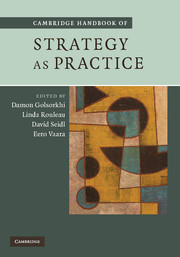Book contents
- Frontmatter
- Contents
- List of figures
- List of tables
- List of contributors
- Introduction: What is Strategy as Practice?
- PART I ONTOLOGICAL AND EPISTEMOLOGICAL QUESTIONS
- PART II THEORETICAL DIRECTIONS
- PART III METHODOLOGICAL TRACKS
- PART IV APPLICATION VARIATIONS
- 18 Institutional change and strategic agency: an empirical analysis of managers' experimentation with routines in strategic decision-making
- 19 Unpacking the effectivity paradox of strategy workshops: do strategy workshops produce strategic change?
- 20 Struggling over subjectivity: a critical discourse analysis of strategic development
- 21 Strategizing and history
- Author Index
- Index
- References
21 - Strategizing and history
Published online by Cambridge University Press: 05 October 2012
- Frontmatter
- Contents
- List of figures
- List of tables
- List of contributors
- Introduction: What is Strategy as Practice?
- PART I ONTOLOGICAL AND EPISTEMOLOGICAL QUESTIONS
- PART II THEORETICAL DIRECTIONS
- PART III METHODOLOGICAL TRACKS
- PART IV APPLICATION VARIATIONS
- 18 Institutional change and strategic agency: an empirical analysis of managers' experimentation with routines in strategic decision-making
- 19 Unpacking the effectivity paradox of strategy workshops: do strategy workshops produce strategic change?
- 20 Struggling over subjectivity: a critical discourse analysis of strategic development
- 21 Strategizing and history
- Author Index
- Index
- References
Summary
Introduction
The living role of history has so far been missing in the Strategy as Practice literature. This chapter emphasizes strategizing in the context of time and suggests a dialogical openness to the past. The literature on Strategy as Practice predominantly sees practice ‘as something that firstly can be chosen and aligned through some form of deliberative weighting on the part of a strategist (albeit on a micro-social scale), and secondly, can be observed and classified by a researcher in terms of its outputs, or effects’ (Chia and Holt 2006, p. 637). Here, a challenge is to interlink close observations of the micro-level activities of people ‘with a continuous regard for the wider institutional context that informs and empowers such activities’ (Johnson et al. 2007, p. 22). Even if scholars taking up this challenge put individuals' activities in context, the contextual dimension of time is still seldom included, eschewing historical frameworks.
The aim of this chapter is to take the Strategy as Practice perspective a step further by elevating the historical dimension as a living tradition that shapes present future-oriented activities performed by practitioners in their representation and reconstruction of the past. Our focus centres on strategizing in relation to hermeneutical situatedness, prompting a dialogical openness to the past. Hermeneutical situatedness allows the practitioner to take on the appearance of a social historical being always affected by the testimony of history and under its influence (Gadamer 1989).
Information
- Type
- Chapter
- Information
- Cambridge Handbook of Strategy as Practice , pp. 326 - 343Publisher: Cambridge University PressPrint publication year: 2010
References
Accessibility standard: Unknown
Why this information is here
This section outlines the accessibility features of this content - including support for screen readers, full keyboard navigation and high-contrast display options. This may not be relevant for you.Accessibility Information
- 3
- Cited by
